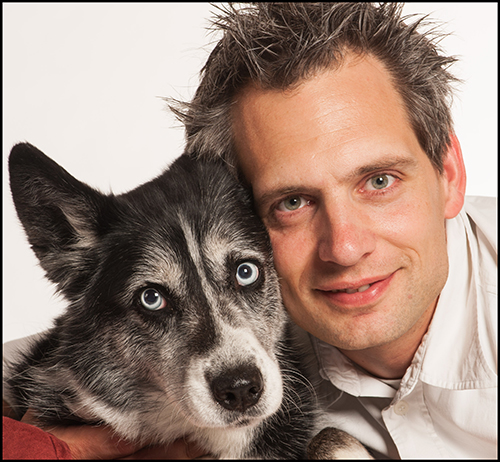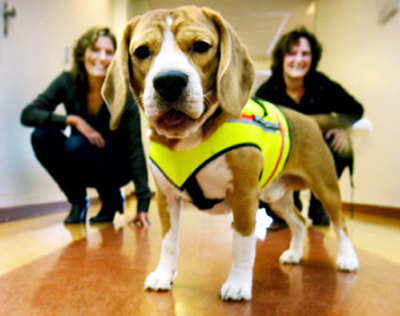Though only in the pilot study phase, results correlate with earlier studies where both dogs and humans were able to “smell” specific diseases in people
Man’s best friend has risked life and limb to save humans for centuries. Now, researchers in Germany have discovered that pooches may be useful in the fight against COVID-19 as well, along with the added benefit that such testing would be non-invasive. In fact, some people believe disease-sniffing dogs may give clinical laboratory testing a run for its money.
Further, even if this approach were not warranted as a clinical diagnostic procedure, trained dogs could be deployed at airports, train stations, sporting events, concerts, and other public places to identify individuals who may be positive for SARS-CoV-2, the coronavirus that causes the COVID-19 illness. Such an approach would make it feasible to “screen” large numbers of people as they are on the move. Those individuals could then undergo a more precise medical laboratory test as confirmation of infections.
In cooperation with Bundeswehr, the German Armed Forces, scientists at the University of Veterinary Medicine Hannover (TiHo), along with scientists from the Hannover Medical School and the University Medical Center Hamburg-Eppendorf, carried out a pilot study with eight specialized sniffer dogs from the Bundeswehr to find people infected with the coronavirus.
After only one week of training, the dogs were able to accurately detect the presence of the infection 94% of the time.
According to a live interview, which featured Holger Volk, PhD, Department Chair and Clinical Director of the Small Animal Clinic at the University of Veterinary Medicine Hannover and Maren von Köckritz-Blickwede, PhD, Professor of Biochemistry of Infections and Head of Scientific Administration and Biosafety at the Research Center for Emerging Infections and Zoonoses at TiHo, “The samples were automatically distributed at random and neither the dog handlers involved nor the researchers on site knew which samples were positive and which were used for control purposes. The dogs were able to distinguish between samples from infected (positive) and non-infected (negative) individuals with an average sensitivity of 83% and a specificity of 96%. Sensitivity refers to the detection of positive samples. The specificity designates the detection of negative control samples.
The researchers published their findings, “Scent Dog Identification of Samples from COVID-19 Patients—A Pilot Study,” in the open access, peer-reviewed journal BMC Infectious Diseases in July.
In their published study, the authors wrote, “Within randomized and automated 1,012 sample presentations, dogs achieved an overall average detection rate of 94% with 157 correct indications of positive, 792 correct rejections of negative, 33 false positive and 30 false negative indications.” They concluded, “These preliminary findings indicate that trained detection dogs can identify respiratory secretion samples from hospitalized and clinically diseased SARS-CoV-2 infected individuals by discriminating between samples from SARS-CoV-2 infected patients and negative controls. This data may form the basis for the reliable screening method of SARS-CoV-2 infected people.”
In the live interview, Dr. Köckritz-Blickwede said, “We think that this works because the metabolic processes in the body of a diseased patient are completely changed,” adding, “We think that the dogs are able to detect a specific smell of the metabolic changes that occur in those patients.”

Using Dogs as Part of Clinical Laboratory Testing
The American Kennel Club (AKC) estimates that a dog’s sense of smell is 10,000 to 100,000 times greater than that of humans. This gives dog’s the ability to detect diseases in early stages of development.
“The next steps will be that we try to differentiate between sputum samples from COVID patients versus other diseases, like, for example from influenza patients,” said Köckritz-Blickwede. “That will be quite important to be able to differentiate that in the future.”
“This method could be employed in public areas such as airports, sport events, borders or other mass gatherings as an addition to laboratory testing, helping to prevent further spreading of the virus or outbreaks,” the live interview description states.
During a pandemic, employers might be able to use dogs to screen employees as they arrive for work. Dogs also could be used as an alternative or in addition to clinical laboratory testing to help prevent the spread of COVID-19. But more work must be done.
“What has to be crystal clear is that this is just a pilot study,” said Volk. “So, there is a lot of potential to take this further to really make it possible to use these dogs in the field.”
An article on the VCA Hospitals website, titled, “How Dogs Use Smell to Perceive the World,” states that dogs devote much of their brain power to the interpretation of smells and they have more than 100 million sensory receptor sites located in their nasal cavity.
By contrast, humans have only six million sensory receptor sites in their nasal cavity. The area of a dog’s brain that is dedicated to the analysis of odors is about 40 times larger than the comparable part of a human brain and dogs are capable of detecting odors thousands of times better than humans.
The article also further explains how dog’s olfactory glands are very unique when compared to other animals and humans. “Unlike humans, dogs have an additional olfactory tool that increases their ability to smell. Jacobson’s organ is a special part of the dog’s olfactory apparatus located inside the nasal cavity and opening into the roof of the mouth behind the upper incisors. This amazing organ serves as a secondary olfactory system designed specifically for chemical communication.
“The nerves from Jacobsen’s organ lead directly to the brain and are different from the other nerves in the nose in that they do not respond to ordinary smells. In fact, these nerve cells respond to a range of substances that often have no odor at all. In other words, they work to detect “undetectable” odors.”
VCA Hospitals is a chain of veterinary hospitals with more than 1,000 facilities located in 46 states and five Canadian provinces.

Dogs are amazing, that’s for sure. But for canines to become widely used to detect infections there would have to be a way to validate each dog’s ability to detect diseases, so that the diagnostics would be consistent across all the dogs being used.
So, while there appears to be potential for utilizing a dog’s uncanny sense of smell to detect disease—including COVID-19—more research is needed before development of clinical testing can take place. And, perhaps, a set of canine billing codes.
—JP Schlingman
Related Information:
Dogs Are Able to Detect Presence of Coronavirus by Sniffing Human Saliva, New Study Finds
Trained Dogs Were able to Sniff Out Covid-19 Infections with 94% Accuracy: Study
Scent Dog Identification of Samples from COVID-19 Patients – a Pilot Study
Dogs Detecting Disease: Meet America’s Cancer-Sniffing Canines
How Dogs Use Smell to Perceive the World
Live Interview: Diagnoses by Dog Noses—Dogs Can Sniff Out Patients with COVID-19



